Click here to see this email on the web
|
 |
Friday, August 30th, 2024
|
|
Drawing with Expression, Not Expectation |
By Agnes Grochulska
|
Share this article:    
|
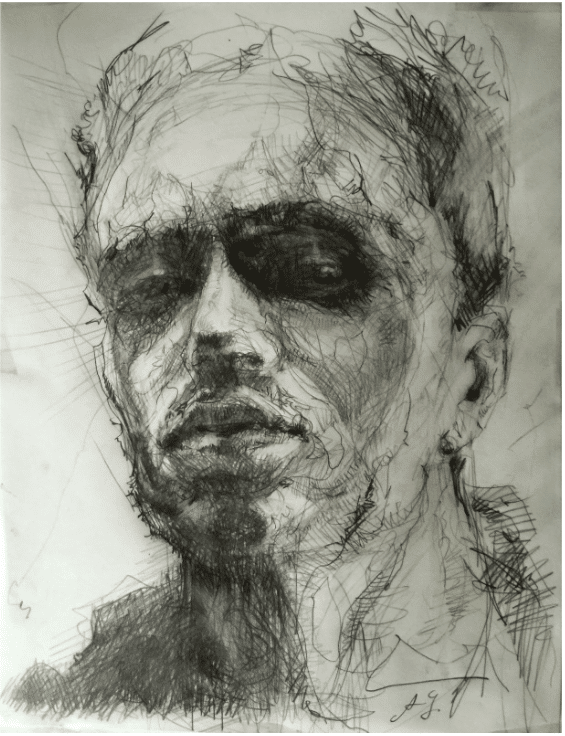 |
Agnes Grochulska, “Portrait #17,” graphite, 9 x 11 in.
|
If you sketch often and don’t feel too precious about the outcome, you can allow yourself to stop at whatever moment you like the drawing best, no matter the level of completion.
Creating quick gestures in ink helps me focus on the process rather than the finished result. A gestural approach to drawing has a lot to do with emotions and allows me to draw more instinctively. Sketching in this casual way gives me a space where I can investigate the subject matter out of curiosity and without any expectations as to how the finished drawing should look.
Responding with a simple line to an impulse that initially got me interested in the subject is one of the most enjoyable aspects of sketching for me. Satisfying the initial curiosity in an open-minded, free way — by just sketching expressively without following certain previously learned rules — is something that is often called “loosening up.”
Drawing or painting as a way of getting to know your subject, investigating, and just being present in its presence by observing its features and responding to it with a mark on the paper, a line. A line both creates a boundary between areas and connects them. Contour line specifies and informs our brain where an object ends.
By putting a line on my paper I feel I am both describing the division between me and the drawing subject, and connecting with it.
|
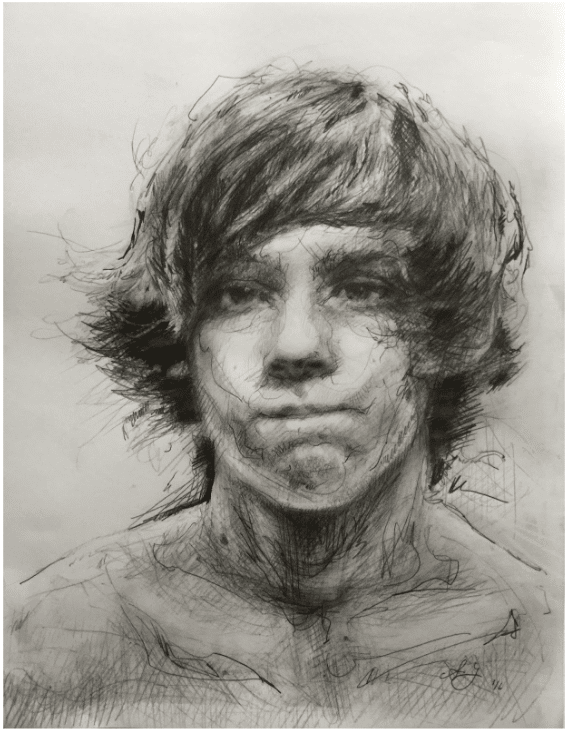 |
Portrait #18, graphite drawing, 9 x 11 in.
|
By drawing fast and relying on my instinct in putting the lines in a gestural way, I’m hoping to grasp the most important information, the essence of my subject. Timing myself to short drawing sessions (from 1-minute contour line drawing to 10-minute studies), I narrow the choices of what’s essential — to first register, then to communicate, and by what means. There are only so many marks and details one can put on a paper in a very short time like that.
The choice of ink adds restrictions. The permanent character of ink makes me consider each decision carefully, knowing I will not be able to erase it.
Interestingly, I found out I make fewer mistakes when drawing with ink, than when I use an easily correctable tool like pencil or charcoal.
Drawing in this casual way lets my hand and mind get lost in the abstract world of shapes and angles, rather than think in an intellectual way about my composition. And dynamic, expressive line communicates more information, and like the movement, emotion. It can also create focal interest and bring the viewer’s attention to one particular part of the drawing.
One way to keep the line interesting and lively is to try different ways of holding the pen and originating your movement from your elbow or shoulder. That way the energy comes from your body, and the drawing marks are more fluid and organic looking. Varying the pressure of pen and the shape and direction of marks adds unique irregularity to the final image.
Related Article > Drawing the Figure: Heads, Hands, and Feet by Juliette Aristides
Convenience
I like the minimalist requirements of ink pen sketching — all I need is a piece of paper and an ink pen. There is always something around to draw.
The pens I like to use are the Muji brand gel pens, and Micron and Rotring ink pens in various sizes. I have a small 6 x 8-inch (Muji) sketchbook I like to carry around with me, but for sketching in my studio I use a bigger 9 x 12-inch format of Canson and Strathmore drawing pads. Regular print copy paper is a great and inexpensive paper that I can experiment on and not feel bad about tossing away later.
Find what works for you — what size is easy enough to carry around and what drawing tool doesn’t require extra set up? In my experience, if it’s a hassle to use or requires preparation or cleaning up after, there is a big chance I’ll give up on lugging it around with me.
Try different materials; find a pen or pencil you like. Change your favorites often, too — you might be surprised how different your work looks depending on the drawing supplies you use. A challenging tool or size might develop eventually into a new artistic idea or direction altogether.
|
— advertisement —
|
 |
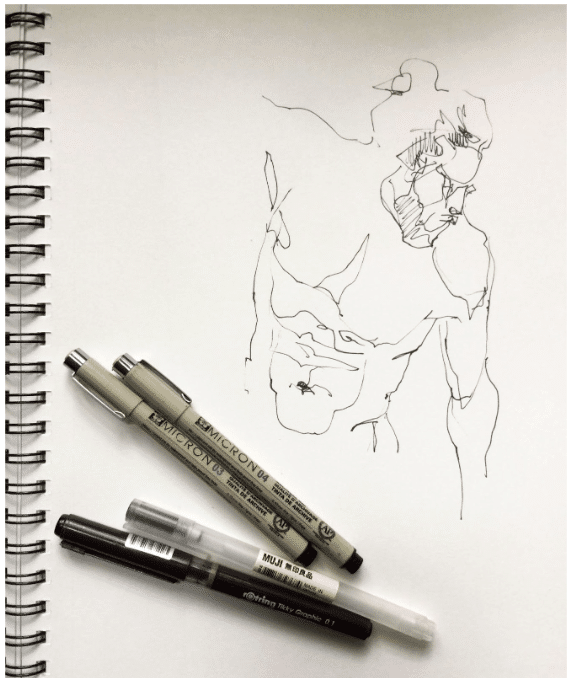 |
Ink sketch, 9 x 12 in.
|
Art Inspiration
Draw what draws you! I feel that my drawings turn out best when I am interested in my subject and feel excited to draw it. Naturally, my interests change on a case-by-case basis. Frequently it’s something that catches my attention because it’s right in front of my eyes — that was the case with the sketches of animals.
I drew chickens and horses from a nearby farm while on a family vacation. The chickens were a lot of fun to watch, with their robot-like head movements, random hops and runs, the contrast between the fluffy feathers and sharp claws and beaks.
|
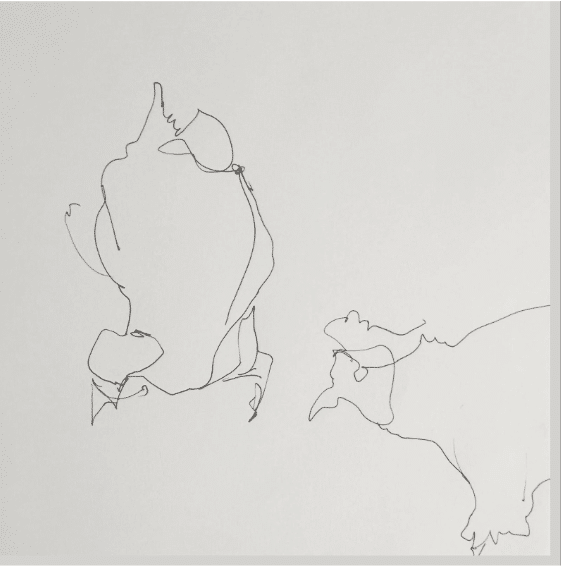 |
Ink sketch, 6 x 8 in.
|
The horses — with their handsome, wise heads turning slowly — seemed to be in a contemplative mood that day.
|
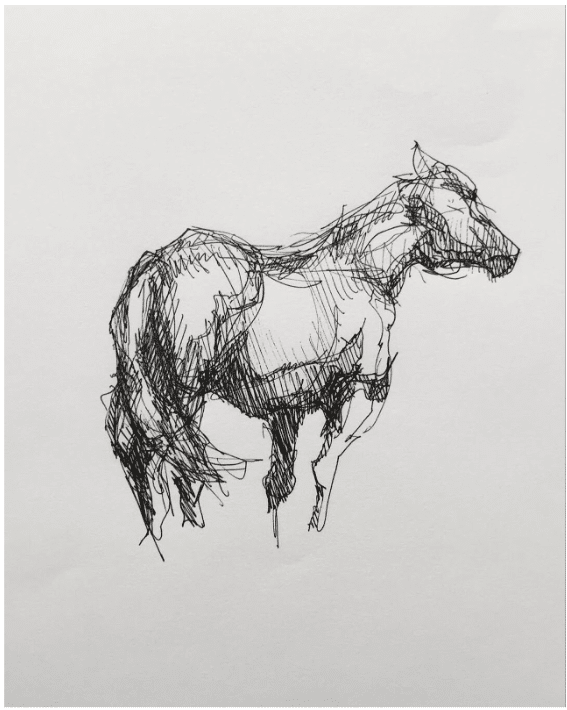 |
Ink sketch, 9 x 12 in.
|
 |
Ink sketch, 6 x 8 in.
|
Pigeons always looked funny to me. I am not a big fan of birds seen up close, with their beady eyes and scaly little feet. Don’t they look like tiny dinosaurs? But pigeons (from afar) are funny and full of personality, and I often sketch them in parks.
|
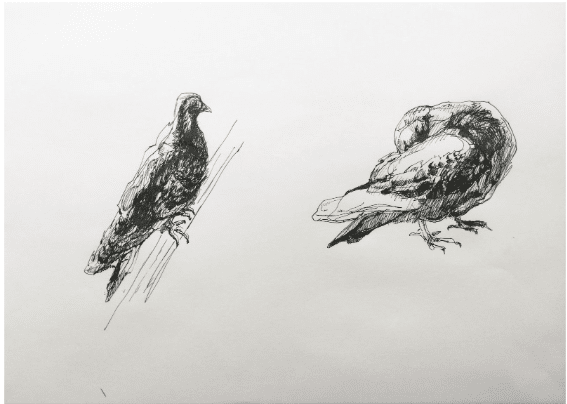 |
Ink sketch, 9 x 12 in.
|
 |
Ink sketch, 9 x 12 in.
|
My two cats lounging lazily on a hot and humid summer day offered a perfect drawing subject — they didn’t change their poses too quickly and were happy to keep me company on our front porch. You can see short drawing videos of me drawing my cats (featuring the model Mia) on my Instagram and Facebook pages.
|
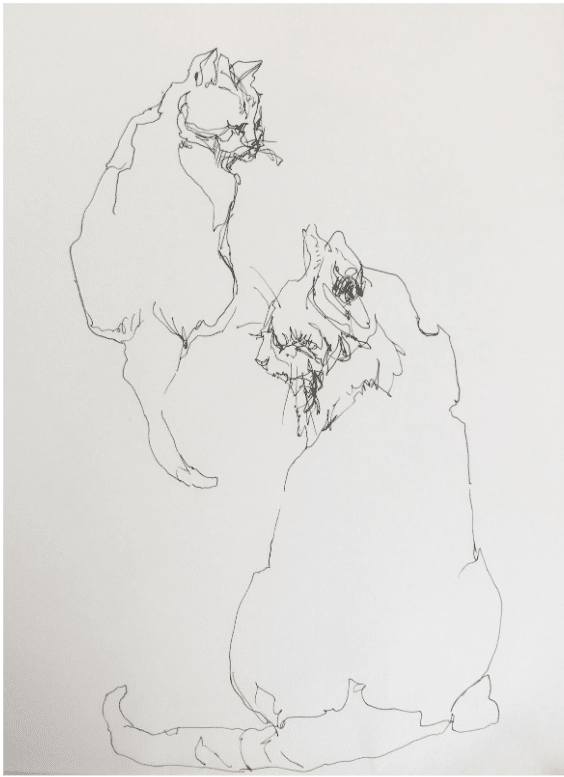 |
Ink sketch, 9 x 12 in.
|
Drawing People: Not without a reason people are the favorite and most popular subject of many artists. Naturally, we feel drawn to our human form both as artists and viewers, me included. Family members, friends, random coffee shop goers — nobody is safe around here. And let’s not forget the gift of professional models — offering us artists endless hours of poses, holding still facial expressions and tightly drawn muscles. Nude figure especially is an ideal subject for drawing practice and further development of understanding the form of the human body.
|
 |
Ink sketch, 6 x 8 in.
|
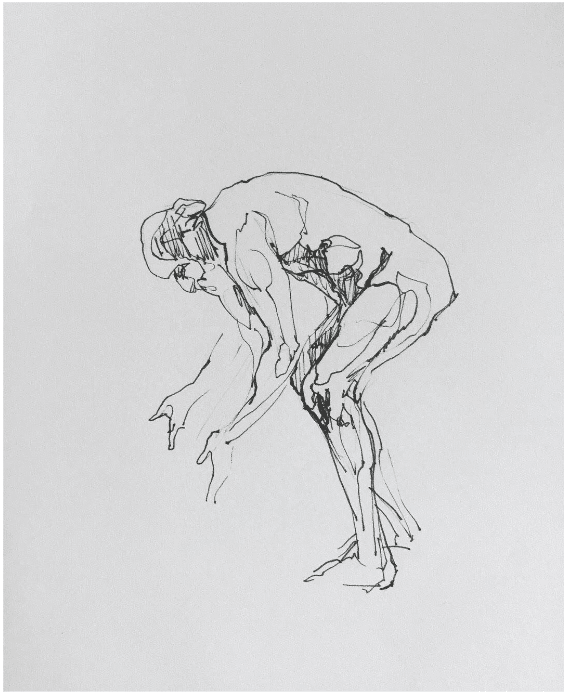 |
Ink sketch, 9 x 12 in.
|
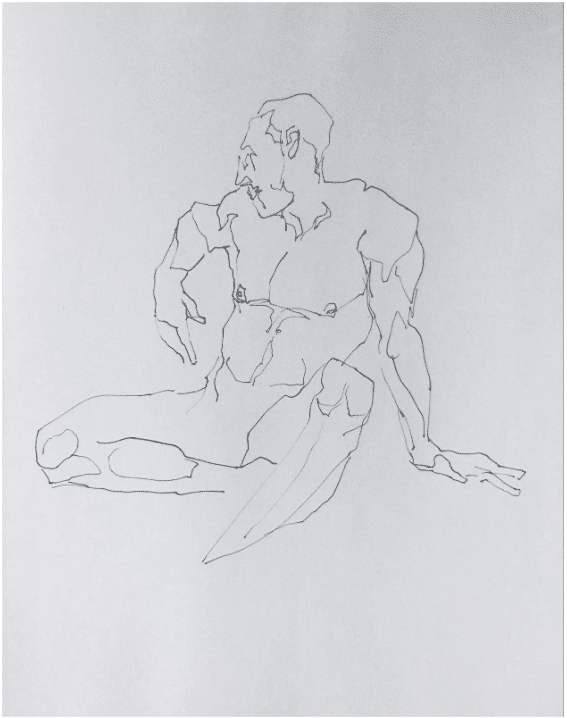 |
Ink sketch, 9 x 12 in.
|
Portrait is another personal favorite of mine, trying to capture the emotion and personal stories in somebody’s features. And not just faces. Hands are full of emotion and express so much information through gestures and movement.
Of all the parts of the body, hands are often considered to be the hardest to draw. It is true that their intricate construction and seemingly infinite number of possible positions and gestures might feel overwhelming at times. The only way to be able to draw the hand is to understand it, and the way to understand it is by both studying the anatomy and mechanics of the hand, and practicing drawing and painting it.
|
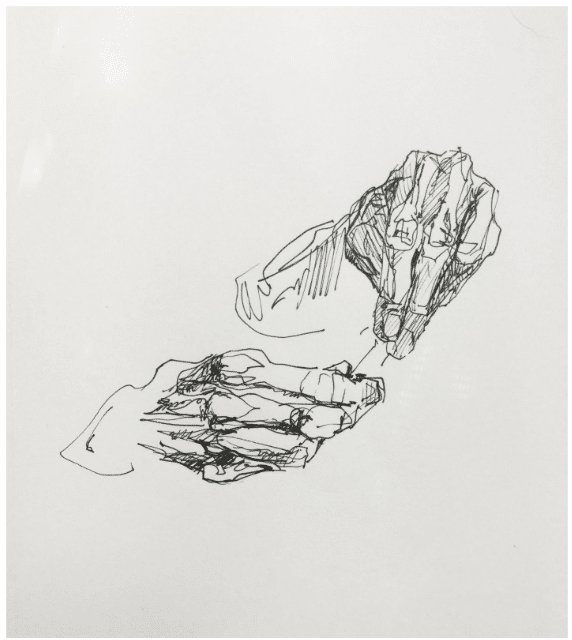 |
Ink sketch, 6 x 8 in.
|
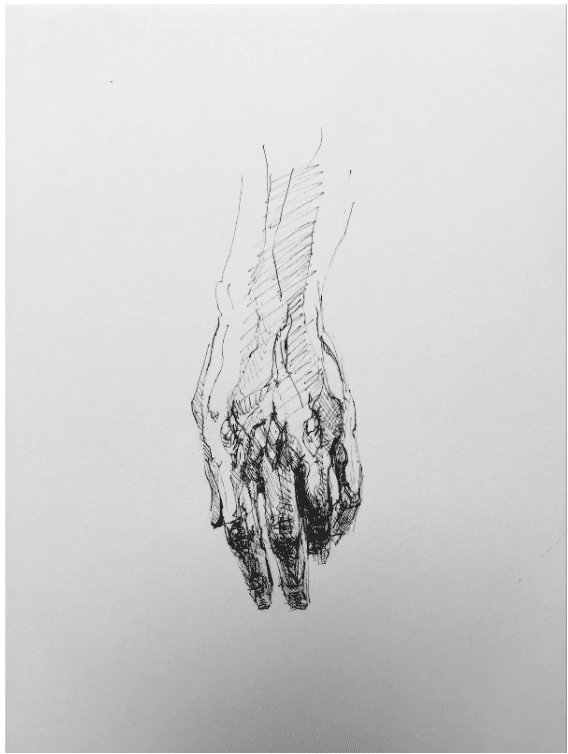 |
Ink sketch, 9 x 12 in.
|
|
|
|
— advertisement —
|

|
There are a lot of resources available both in print and online to learn from, including books by Bridgeman and Loomis, Proko, and Line of Action websites. Copying well-drawn hands (paintings and drawings of the great masters), and drawing sculptures is a well-tried and a great way to study them.
I prefer to draw from life, and if I don’t have a model available I use my own (left) hand for quick studies, or take my own photographs and later use them as drawing resources.
Process: Hand Study in Ink
|
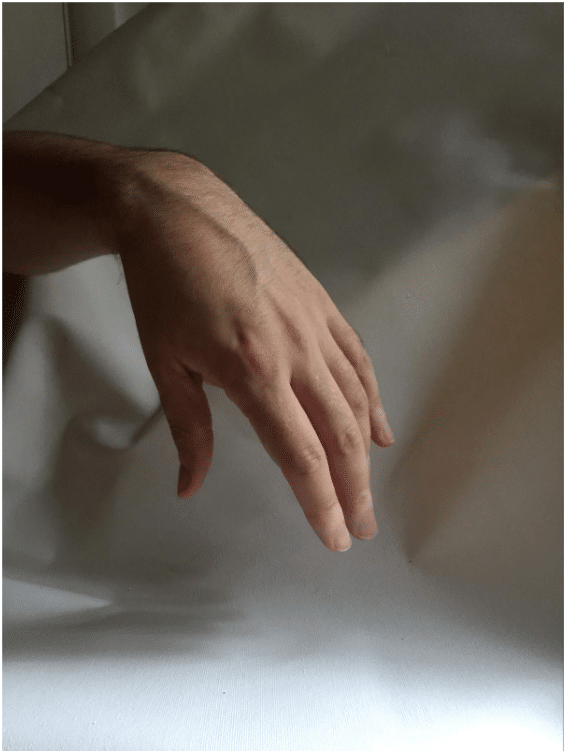 |
|
Photo reference.
|
There are different methods and schools of gestural drawings. The start is particularly important. My choice of the way I’m going to start a particular drawing is somewhat impulsive and has to do with what I find most important or unique to this particular theme.
Sometimes I will start by identifying the “line of action,” and put down the line or lines identifying the movement or general direction. Drawing the basic shape or shapes first in a slight outline helps to organize complicated compositions. In figures, it is helpful to lightly mark the basic skeleton first — the skull, spine, and the shoulder and hip axis. In objects with strong contrasting light I might start with marking the darkest darks first.
In this particular hand position I like the soft falling line of the wrist, and the way the hand hangs suspended in the air, so I’m going to start with that outer edge starting from the top and going down to the fingertip.
When making that line I keep my eyes on the subject and not on my paper following the movement of my eyes with the movement of my pen. As Paul Klee said, “A drawing is simply a line going for a walk.”
|
 |
The first (contour) line…
|
Shall we walk a little farther?
I follow the contour of the hand and outline the shapes in a somewhat continuous line — almost without taking my eyes off the subject or lifting my pen off the paper.
It isn’t exactly a blind contour drawing, but close to it. It helps to focus my mind on seeing the shapes in front of my eyes the way they really look — as shapes, lengths, angles, and values, rather then named body parts and ideas of how a particular part should look.
It is a well-known theory that by not naming things as “fingernail” but rather as “an oval, slightly uneven on the right and flattened on the bottom,” we free our minds from acquired, idealized symbols of things. Only then can we form a true description of the individual, unique thing in front of us, and also develop our personal, original style, and artistic voice.
|
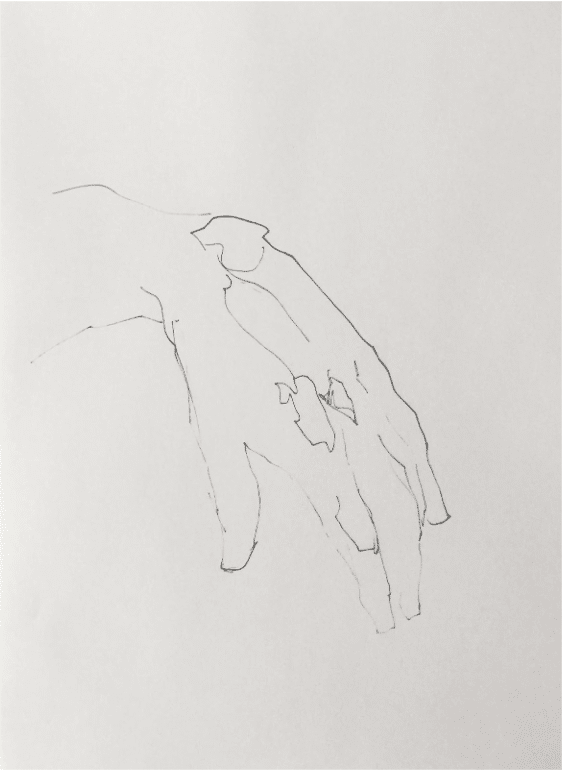 |
Seeing the shapes as JUST shapes and following the contours with the eye, while the pen stays on the page.
|
I find it important to think of the palm of the hand as a part of the whole arm, both in construction and gesture. It helps to visualize the bones and muscles inside, and pay particular attention to the position of the wrist. This is where being familiar with hand anatomy comes in, yes, handy. And even though I don’t remember the names of each of the tiny bones as I draw, I’m imagining the carpal and metacarpal bones hidden under the skin and muscle, and the way the ulna and radius in the arm are connected to the wrist.
Every line and shape I’m putting at this time has a function of creating the correct structure of the hand. I’m trying to think of perspective, and how the form turns in space — observing and understanding what shapes are in front of or behind one another.
|
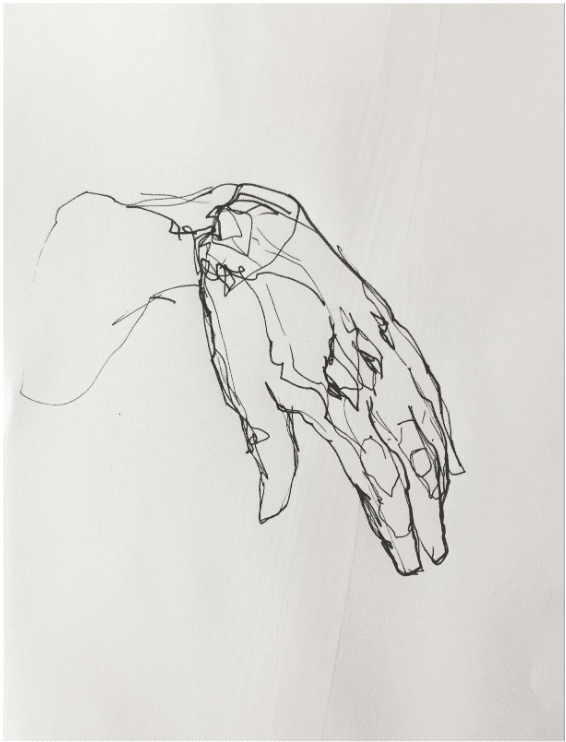 |
Visualizing the inside while following the contours of the outside.
|
Next comes light and shadow. Squinting my eyes to see the contrast better, I am outlining the shadow and highlight areas. Values build up by adding more lines, cross-hatching the darkest darks.
Notice reflected light in the back, inside the palm that makes the form look round. Darkest accents like finger creases and interesting details are added to finish the sketch.
The whole exercise took about three minutes.
|
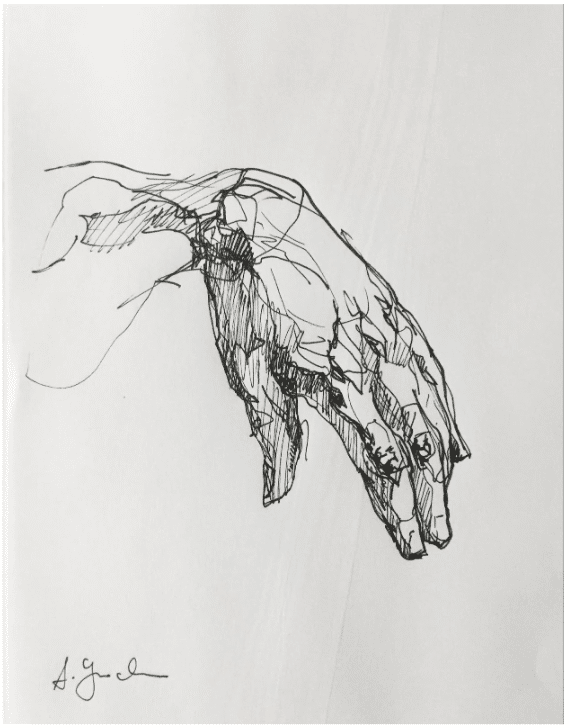 |
The completed sketch.
|
In those kinds of sketches, I draw fast and produce many drawings. I remember reading that Egon Schiele’s contour sketches that we so admire now are actually the very few that survived out of the many tries. Apparently, he would have a huge stack of paper and start his line drawing in front of a model. If he didn’t like how the drawing was looking, even after the initial line, he’d toss the paper and start over.
This time he might have succeeded in putting a beautiful contour of the hand but didn’t like the start on the torso. That paper goes to the trash and he starts from the beginning again. Over and over again. It’s good to know that the artists we admire didn’t create the artworks we love in one perfect sitting each time. It should help us not be afraid of failing either.
Drawing loosely lets me feel less pressure about the outcome and enjoy the drawing process instead. An idea about “a finished drawing” is just that — an idea. When I don’t feel too precious about the outcome I allow myself to stop at whatever moment I like the drawing best, no matter the level of completion.
Some of the drawings you see here are just contour drawings. If it feels like I accomplished what wanted in the contour itself, if the image “clicks” and speaks to me, then that’s it. That’s the finished drawing. If it feels like developing some aspects or ideas, I will describe the form further, building lights and shadows and adding details. And there are some that simply don’t work at all — the drawings that end up tossed away. Even those messed-up drawings are valuable. Failed results don’t mean the process failed, or the time exploring the idea was wasted.
Recognizing and learning from our “bad drawings” might be the most valuable part of the whole practice! Being comfortable exploring different options and not focusing on being “right” allows our own sensitivity to explore different ideas and ways of representing what’s in front of us and eventually finding our own artistic voice.
Additional Art: Figure Drawings and Sketches
|
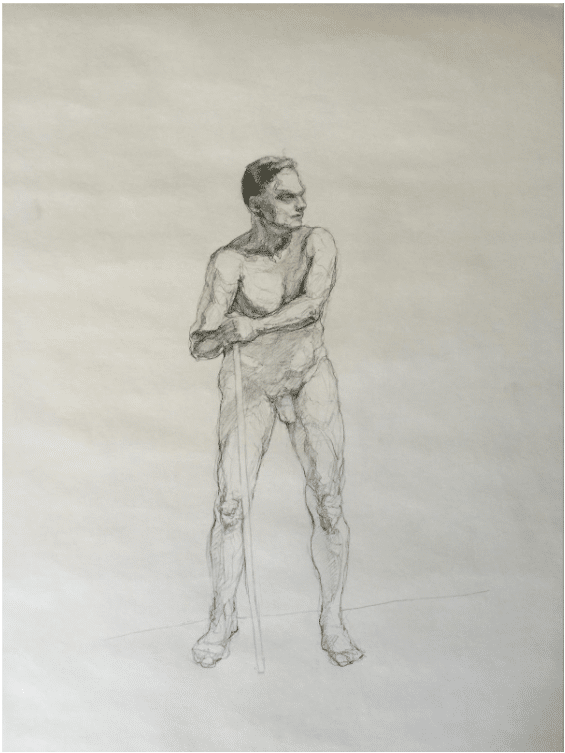 |
Graphite sketch, 12 x 16 in.
|
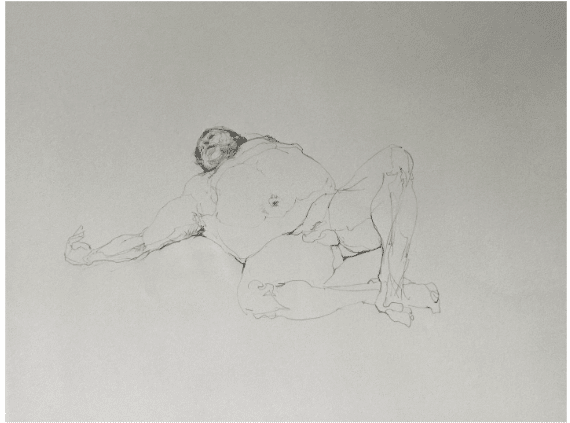 |
Graphite sketch, 14 x 10 in.
|
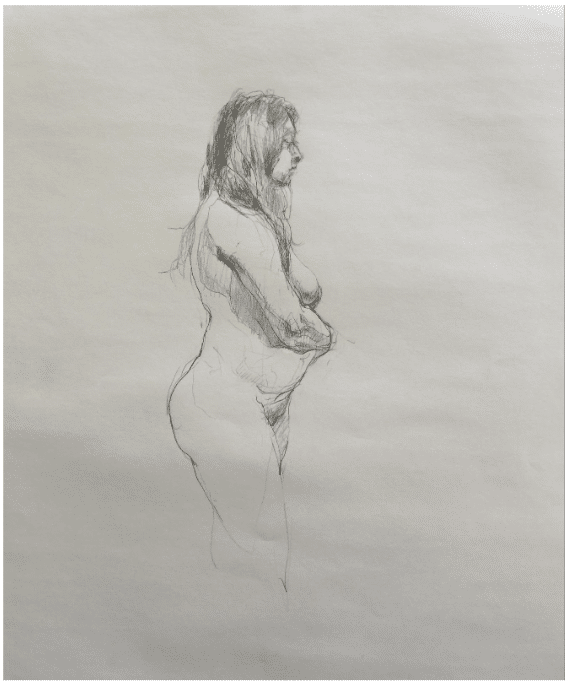 |
Graphite sketch, 10 x 14 in.
|
ABOUT THE ARTIST
|
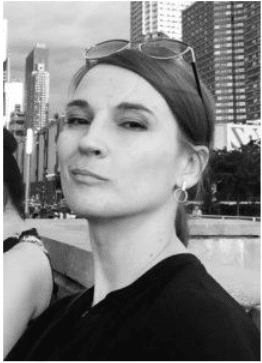 |
Contemporary artist Agnes Grochulska
|
Agnes Grochulska is a contemporary realist painter working mainly in oils. She also enjoys creating drawings in graphite and charcoal.
Grochulska studied design at the Academy of Fine Arts in Warsaw, Poland. She currently resides in Richmond, Virginia, and her art can be viewed at the local Eric Schindler Gallery. Her work has been also shown at Dacia Gallery in New York City, The Frank Gallery, and Conde Contemporary in Miami, Florida. Grochulska’s work has received several awards and has been published in Artist’s Magazine, Drawing Magazine, Poets and Artists Magazine, and Strokes of Genius. Her drawings and paintings are in the Del Cerro Family Collection as well as the DaLuz Collection.
Grochulska is interested in a broad spectrum of themes and subjects in her art. She is drawn to the human subject with all the emotion, meaning, and importance that only the human form can carry. Sculpture as a still life — a three-dimensional object being the subject of a two-dimensional drawing or painting — is something that fascinates her as she explores this theme in her new projects. Another idea she is following is the landscape around her, as she tries to capture the essence of the place, the moment, and the feeling.
Drawing is a fundamental tool in visual artmaking. Get the training you need from the pro’s in one of the videos available here.
|
|
|
|
|
|
Inside Art is committed to protecting and respecting your privacy. We do not rent or share your email address. By submitting your email address, you consent to Streamline Publishing delivering regular email issues and advertisements. To end your Inside Art e-mail subscription and associated external offers, unsubscribe here. To learn more about Streamline Publishing events,
products, and offerings visit StreamlinePublishing.com
Copyright 2024 Streamline Publishing, Inc. All rights reserved.
Inside Art® is a registered trademark of Streamline Publishing, Inc.
|
|
|
|
|